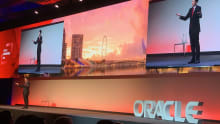As uncomfortable as it is, disruption is here to stay: Alison Sibree, Oracle

Let’s Talk Talent Read similar articles

“Going through disruption can be fun, frightening, or frustrating depending on the generation you are from,” stated Alison Sibree, Senior Vice President Human Resources, JAPAC, in a session at Oracle OpenWorld Asia. But it as an imperative that organizations are disruptive otherwise they won’t survive long. And HR has to be at the forefront of preparing for challenges that they will go through.
There was a time when change was organized, consistent and slow and not so frequent. But today, change happens every day.
The fact is that change has never happened this fast and it will never be as slow as it was in the future. And we have to get used to it and prepare for it emotionally, physically, intellectually. We ignore disruption at our peril. Businesses have been disrupted out of existence. Alison shared only 12% of the Fortune 500 companies from 1955 are still on the list which means only 60 such companies have survived till now. This makes anticipating change early on an imperative for businesses and HR.
HR needs to anticipate change
Thus HR as a function needs to anticipate these trends for business and cultural changes. The accelerating rate of change puts urgency on the way HR responds to business needs. Research by Deloitte that illustrates rates of change and adoption in the society validates the same-the technology curve has been steadily outpacing individuals and businesses and public policy.
It is crucial that businesses and individuals don't grow too far apart. If organizations want to attract and retain the right workforce, they have to ensure that the technology they have keeps people interested. Millennials won’t stay in the organization if they don’t have the excitement and the challenge of using up to date advanced technology. So organizations have to keep moving technology at a faster rate than individuals.
Here's a six-stage plan which organizations can use to stay at the top of the curve and keep their employees excited and engaged.
Acceleration of experimentation
Experimentation is not just about product development-it's also about workforce design as to how we are structured to meet the challenges of the external marketplace. For instance, Oracle has restructured its salesforce around ensuring that it is using a lot of technology as a means of attracting clients. The company established digital hubs around the region, focused on providing Oracle’s latest cloud offerings to the small and midsize business segment. The hubs are fitted with state-of-art tools to include the latest collaboration tools, techniques, and technologies to transform the buying and selling experience.
HR’s responsibility is to hire people who are excited about the opportunities and challenges at these hubs.
Engagement through ample opportunities
In today’s world, it is imperative that organizations focus most on attracting and retaining employees. Careers and mindsets have changed, and jobs change every three to four years. So organizations have to ensure that employees own their careers and take an interest in what they want to do. They have to make sure that they provide them with the skills, the knowledge, the technology and the career growth to retain them in the organization.
Millennials will be almost 50% of the workforce in 2020, and they tend to be very concerned with career development.
Oracle’s JAPAC workforce now consists of 60% millennials and its internal surveys indicate that these people want to have career growth opportunity every three years. So one of the initiatives it has taken is to set up a group of recruiters who make sure these employees have the opportunity for lateral movement in the organization to keep them excited and fulfilled. Employees are also encouraged to keep their profiles updated so that the organization knows what they want to do next.
Embracing data-fication
Data-fication is a critical requirement in the business now and Oracle hires skilled people to do predictive analytics. Business leaders today depend on data and require data on an immediate basis. They want to spend less time debating data but more time on the insights that come from the data. They want more dashboards and fewer reports. And it is imperative for an organization to have those people who are refreshing the data, to come up with insights as to what drives the organization and its employees, what does a good employee look like, what are some of the correlations that we may get across business operations, the underlying drivers of attrition, among many others.
Rethinking learning and development
Skills have a reduced shelf life and disruption requires continuous re-learning. Organizations have to determine what type of learning people want. We now have four generations in the workforce and each one of those generations tends to learn in different ways. So how do we keep learning fresh in the minds of these people? Organizations today are moving from corporate prescribed learning to employee-driven learning. Through assessments, Oracle has learned that when it comes to learning initiatives, employees who actually tapped into their profiles to see where their skills were deficient, showed an improvement of 8% next time around.
Providing a superior digital experience
Organizations today need to give their employees the same digital experience as they are being exposed to through new age firms such as Google, Amazon, Facebook, and Netflix. If the technology gap widens between what an employee wants to do and what the company can provide, organizations won’t be able to retain these employees. Neither will they be able to attract people if they are not able to satisfy their career expectations. There was a time when personal tools were inferior to what the company provided. But today millennials possess equipment far superior to what the companies can give. So companies have to watch out for that as a wonderful digital experience is what keeps people excited and makes coming to work fun.
Continuous performance management
Performance management has been a thorn in HR’s side for many years and ways of giving feedback still remain very inefficient. The annual performance appraisal is not a very pleasant experience for many. More so, for a generation which wants immediate gratification in everything, they want a similar immediacy effect in feedback as well. They want that immediate feedback- that immediate like or dislike, what they have done well or what they could do better. Millennials are not going to wait for that annual process which probably leaves them frustrated. What they want is a continuous process, continuous goal setting and continuous feedback to keep them engaged.
Ultimately, disruption is here to stay and is going to continue to be a part of our lives. So we have to make sure we are prepared for it. As uncomfortable as it is, it is going to be there and no company can say that it has the solution and has arrived.
Alison aptly concluded, “We are never going to arrive as the goal post will keep on moving and we have to keep on walking the path.”
(This article is based on a session by Alison Sibree, Senior Vice President Human Resources, JAPAC, Oracle at Oracle OpenWorld Asia in Singapore. Click here to know more about the evolving role of HCM and the innovations in HR, powered by Oracle.)







